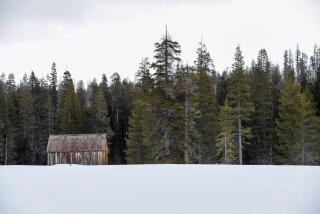Low Sierra Snowpack Means Less Hydroelectric Power
- Share via
In another ominous sign for California heading into summer, when demand for electricity is highest, below-normal snowfall in the Sierra Nevada this winter will mean less water to create hydroelectric power.
State officials Friday measured the accumulated snowfall and found it at 61% of its average level. April 1 is the traditional end of the rain and snow season. The last time the snowpack fell so far below average, in 1994, hydroelectric power production dipped by 25% to 30%.
“Unfortunately, the conjunction of low water and the energy problem is going to be a reason for concern,” said California Department of Water Resources spokesman Jeff Cohen.
As the snowpack slowly melts, water trickles down from the mountains through a ladder-like series of reservoirs and streams, powering hydroelectric turbines on the way.
The poor snowpack means that less water will travel from the mountain reservoirs to the power plants--and that the snow could all melt before summer’s end, straining crucial water supplies.
That, in turn, could compound the electricity problem: Farmers, who will most likely find their water supplies curtailed, will respond by pumping large amounts of ground water to feed their crops, a costly process that sucks up electricity.
Urban water users are not expected to be affected by the light snowpack--this year. But depleted reservoirs could pose drought problems next year if the water shortage hits reservoirs closer to population centers, officials said.
Representatives of Pacific Gas & Electric Co., which operates the largest privately owned hydroelectric power network in North America, said the snowpack news spells trouble.
Hydrologists for PG&E; are still analyzing the snowpack, but have similarly concluded that it is only about two-thirds its usual size. That could mean major problems for PG&E;’s hydro behemoth, the Helms power plant near Fresno, which generates enough power to light up San Francisco.
“This is a horrible mixture when you consider the other factors [that are reducing supplies] in the energy crisis,” said PG&E; spokeswoman Christy Dennis. “Some of those other problems are man-made, but this is Mother Nature. It’s just not looking good for California.”
In a more optimistic prediction, the Central Valley Project, a federal network of dams and reservoirs that stretches through much of the same area, expects to generate about 80% of normal power supplies, said Barry Mortimeyer, chief of CVP power operations.
That is because, despite a thin Sierra snowpack, the state’s biggest reservoirs are relatively full, thanks to the past several years of abundant rain and snow.
Though power will not be drastically curtailed, water deliveries from those reservoirs will be cut dramatically by the dry year, said Jeff McCracken, spokesman for the U.S. Bureau of Reclamation, which runs the CVP.
South of the Sacramento-San Joaquin Delta, where water pumping is constrained by the presence of several species of endangered fish, farmers can expect to get just 40% of the water for which they have contracted from the CVP.
Growers in Northern California, many of whom enjoy generous rights to water, will get full supplies, McCracken said. But the scant snowpack means that reservoirs will get just slight replenishment.
State officials are concerned enough about the possibility of farmers upping electricity use by pumping ground water that the California Energy Commission has begun an outreach program to promote energy efficiency by agribusinesses.
But according to one leading water group, the high cost of electricity may itself force farmers to undertake a draconian conservation measure, one with serious economic consequences: leaving fields fallow.
Frances Squire, spokeswoman for the giant Fresno-based Westlands Water District, said the electricity rate hike imposed Tuesday by the California Public Utilities Commission will double farmers’ cost of pumping ground water.
Because natural gas prices are unusually high, growers who use gas to run their pumps will also be paying more, she said. Those increased energy costs--on top of a water shortage and low market prices for several crops grown by Central Valley farmers--are forcing some growers to cut back.
In other developments:
In their first official reaction to California’s complaint that electricity suppliers overcharged by as much as $6.3 billion, federal regulators said Friday they want to see the math.
The Federal Energy Regulatory Commission said in a letter to California’s grid operator that its claim failed to “include any detailed support for the derivation” of the alleged overcharge. The letter also questioned the California Independent System Operator’s methodology in analyzing the effect of scarcity on prices.
A spokeswoman for FERC said the letter was simply a request for information and should not be taken as an indicator of how the commission will rule.
*
Times staff writer Ricardo Alonso-Zaldivar in Washington contributed to this story.
More to Read
Sign up for Essential California
The most important California stories and recommendations in your inbox every morning.
You may occasionally receive promotional content from the Los Angeles Times.










